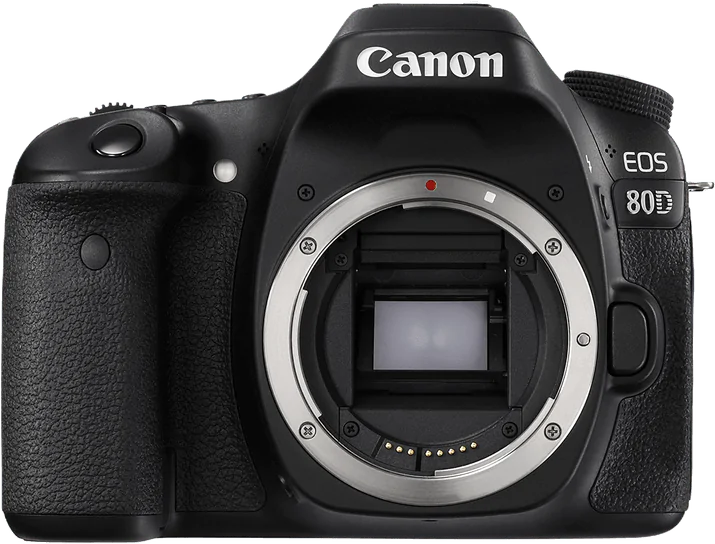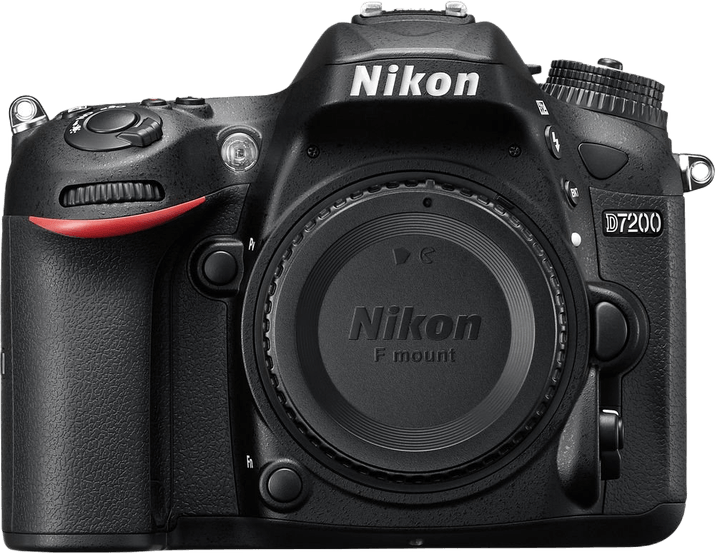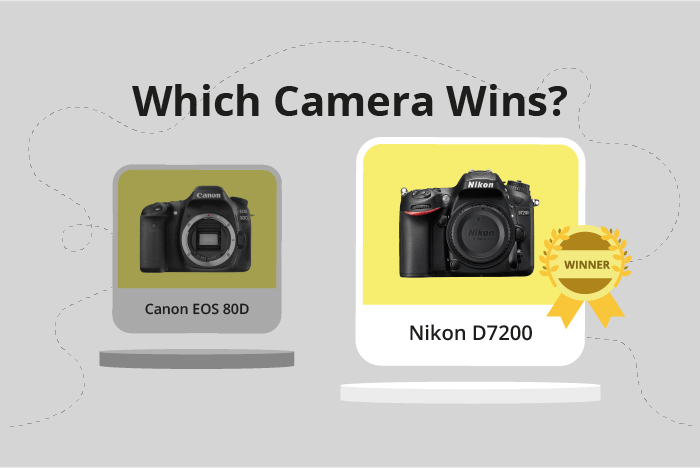Canon EOS 80D vs Nikon D7200 Comparison
Canon EOS 80D

Nikon D7200

The Nikon D7200 takes the lead with a score of 68/100, while the Canon EOS 80D trails with a score of 64/100. Both cameras are DSLRs and were released at a launch price of $1200. They share similar dimensions, with the Canon EOS 80D measuring 139 x 105 x 79mm and the Nikon D7200 at 136 x 107 x 76mm.
The Canon EOS 80D is lighter, weighing 730g (1.61lbs), which can be an advantage for those who value portability. On the other hand, the Nikon D7200, weighing 765g (1.69lbs), has a higher score, indicating better overall performance and features.
Considering these specifications, the Nikon D7200 is the better option for those prioritizing performance, while the Canon EOS 80D may be more suitable for those who prefer a lighter camera.
Canon EOS 80D vs Nikon D7200 Overview and Optics
The Nikon D7200 triumphs over the Canon EOS 80D in optics with a score of 71/100, compared to the Canon’s 63/100. Both cameras have 24.2 megapixels, CMOS sensor types, APS-C sensor sizes, and no image stabilization. They also share similarities in shooting speeds, with the Canon EOS 80D at 7 and the Nikon D7200 at 6.
The Nikon D7200’s higher score results from its superior DXOMARK sensor score of 87, while the Canon EOS 80D has a DXOMARK sensor score of 79. This difference indicates that the Nikon D7200 has better image quality, color depth, and dynamic range. The Nikon D7200 also uses the Expeed 4 processor, while the Canon EOS 80D uses the Digic 6 processor. Additionally, the Nikon D7200 has a Nikon F DX lens mount, which offers a broader range of lens options.
On the other hand, the Canon EOS 80D has a slightly faster shooting speed at 7, compared to the Nikon D7200’s 6. This advantage allows the Canon EOS 80D to capture fast-moving subjects more effectively. The Canon EOS 80D features a Canon EF-S lens mount, which is compatible with a wide range of Canon lenses.
Taking these factors into account, the Nikon D7200 proves to be the superior camera in terms of optics, due to its higher DXOMARK sensor score and more extensive lens options. However, the Canon EOS 80D may be more suitable for those who prioritize faster shooting speeds and are already invested in the Canon lens ecosystem.
Canon EOS 80D vs Nikon D7200 Video Performance
When comparing the video capabilities of the Canon EOS 80D and the Nikon D7200, both cameras receive an equal score of 70 out of 100. This suggests that they have similar video performance, but let’s examine their specifications to determine their strengths and weaknesses.
Both the Canon EOS 80D and the Nikon D7200 share common video specifications. They both have a maximum video resolution of Full HD (1920 x 1080) and a maximum video frame rate of 60fps. Additionally, both cameras have built-in time-lapse functionality, which is useful for capturing creative video sequences.
Despite having the same video score, the Canon EOS 80D has some advantages over the Nikon D7200. These advantages, however, are not specified in the given information. The given information does not provide any specific details on how the Canon EOS 80D outperforms the Nikon D7200 in video capabilities.
Similarly, the Nikon D7200 may have some advantages over the Canon EOS 80D in certain aspects of video performance. Again, the given information does not provide any specific details on how the Nikon D7200 outperforms the Canon EOS 80D.
Based on the provided information, both the Canon EOS 80D and the Nikon D7200 have comparable video capabilities, as evidenced by their equal video scores and shared specifications. Without additional information, it is difficult to determine which camera is superior in terms of video performance. Potential buyers should consider other factors such as price, ease of use, and additional features when deciding between these two cameras.
Canon EOS 80D vs Nikon D7200 Features and Benefits
The Canon EOS 80D wins the features comparison with a score of 70/100, while the Nikon D7200 scores 59/100. Both cameras share some key features, such as a 3-inch screen size, no GPS, WIFI connectivity, and no Bluetooth capabilities.
The Canon EOS 80D outperforms the Nikon D7200 in terms of screen functionality. It has a touchscreen, making it easier to navigate menus and control settings. Additionally, the 80D features a flip screen, which provides more flexibility in shooting angles and is beneficial for vlogging or taking selfies. These features contribute to its higher score.
On the other hand, the Nikon D7200 has a slightly larger screen size at 3.2 inches and a higher screen resolution of 1,228,800 dots compared to the Canon 80D’s 1,040,000 dots. This means that the D7200’s screen can display images and videos with more detail and clarity. However, this advantage is not enough to surpass the Canon 80D’s overall feature score.
In the features comparison, the Canon EOS 80D is a better camera due to its touchscreen and flip screen capabilities, which provide more convenience and versatility in use. The Nikon D7200 has a higher resolution screen, but it lacks the user-friendly features of the 80D. Therefore, the Canon 80D is the superior choice for those who prioritize features in their camera selection.
Canon EOS 80D vs Nikon D7200 Storage and Battery
The Nikon D7200 outperforms the Canon EOS 80D in storage and battery, scoring 79/100 compared to 43/100. Both cameras have similar specifications, accepting SD, SDHC, and SDXC memory cards and lacking USB charging. However, the D7200 surpasses the 80D in key aspects.
The D7200 offers two memory card slots, doubling storage capacity and providing backup options. The 80D only has one slot, limiting its storage flexibility. Additionally, the D7200 boasts a longer battery life, lasting for 1110 shots compared to the 80D’s 960 shots. This extended battery life enables photographers to capture more images before needing to recharge or replace the battery.
The Canon EOS 80D does not present any advantages over the Nikon D7200 in storage and battery. Therefore, the D7200 is the clear winner in this category, offering more storage options and a longer battery life for better overall performance.
Alternatives to the Canon EOS 80D and Nikon D7200
Are you still undecided about which camera is right for you? Have a look at these popular comparisons that feature the Canon EOS 80D or the Nikon D7200:

